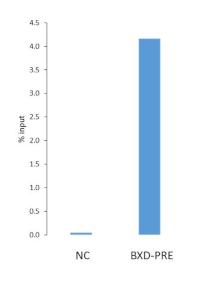1

Anti-RING1 | E3 ubiquitin-protein ligase RING1
AS16 3829 | Clonality: Polyclonal | Host: Rabbit | Reactivity: Drosophila melanogaster
- Product Info
-
Immunogen: Recombinant RING1 of Drosophila melanogaster, amino acids: 150-250, UniProt: Q9VB08 Host: Rabbit Clonality: Polyclonal Purity: Immunogen affinity purified serum in PBS pH 7.4. Format: Lyophilized Quantity: 50 µg Reconstitution: For reconstitution add 50 µl, of sterile water Storage: Store lyophilized/reconstituted at -20°C; once reconstituted make aliquots to avoid repeated freeze-thaw cycles. Please remember to spin the tubes briefly prior to opening them to avoid any losses that might occur from material adhering to the cap or sides of the tube. Tested applications: Chromatin Immunoprecipitation (ChIP), Western blot (WB) Recommended dilution: 3 µg of antibody (ChIP), 1 : 2000 (WB) Expected | apparent MW: 47 | 58 kDa
- Reactivity
-
Confirmed reactivity: Drosophila melanogaster Not reactive in: No confirmed exceptions from predicted reactivity are currently known - Application Examples
-
Western Blot (WB)
Figure 1. Western Blot (WB) result.
20 µg of total protein from Psc/Su(z)2-KO cells (Kahn et al., 2016. doi: 10.1093/nar/gkw701 , line1) and Ras3 (wild type, line2) cells lysed with 1x SDS page loading buffer were separated on 12% SDS-PAGE and blotted 2h to PVDF using tank transfer. Blot was dried and incubated in the primary antibody at a dilution of 1: 2000 for 1h at RT with agitation. The antibody solution was decanted and the blot was rinsed briefly twice in 1x PBS. Blot was incubated in secondary antibody (anti-rabbit IgG AP conjugated, from Promega) diluted to 1:10 000 in for 30 minutes at RT with agitation. The blot was washed as above and developed with NBT/BCIP solution (SIGMA).
Courtesy of Dr. Alexander Glotov. , Umeå University, Sweden
Chromatin Ummunoprecipitation (ChIP)Figure 2. ChIP recovery.
ChIP and qPCR analysis were done as described [Schwartz YB, Kahn TG, Nix DA, Li XY, Bourgon R, et al. (2006) Genome-wide analysis of Polycomb targets in Drosophila melanogaster. Nat Genet 38: 700–705. doi: 10.1038/ng1817]. Chromatin from Ras3 cells was used for ChIP. Quantitative PCR was performed with primers specific for BXD-PRE of Ubx gene (Polycomb target gene in repressed state), used as positive controls, and for intergenic region, used as negative control (NC). Figure 2 shows the ChIP recovery measured by qPCR as a % of input (the relative amount of immunoprecipitated DNA compared to input DNA). Chromatin from 5x107 cells and 3 µg of anti-RING1 antibody were used for ChIP reaction.
Courtesy of Dr. Tatyana Khan, Umeå University, Sweden. - Background
-
Background: RING1 involved in protein ubiquitination.
Alternative names: RING-type E3 ubiquitin transferase RING1Curated, Sex comb extra protein, dRING protein, dRING1. - Protocols
- Antibody Protocols
- Reviews:
-
This product doesn't have any reviews.




